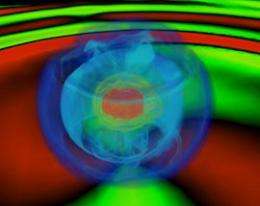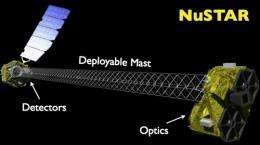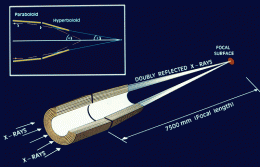Why Won't the Supernova Explode?

A massive old star is about to die a spectacular death. As its nuclear fuel runs out, it begins to collapse under its own tremendous weight. The crushing pressure inside the star skyrockets, triggering new nuclear reactions, setting the stage for a terrifying blast. And then... nothing happens.
At least that's what supercomputers have been telling astrophysicists for decades. Many of the best computer models of supernova explosions fail to produce an explosion. Instead, according to the simulations, gravity wins the day and the star simply collapses.
Clearly, physicists are missing something.
"We don't really understand how supernovas of massive stars work yet," says Fiona Harrison, an astrophysicist at the California Institute of Technology. The death of relatively small stars is better understood, but for larger stars — those with more than about 9 times the mass of our sun — the physics just doesn't add up.
Something must be helping the outward push of radiation and other pressures overcome the inward squeeze of gravity. To figure out what that "something" is, scientists need to examine the inside of a real supernova while it's exploding — not a particularly easy thing to do!

But that's exactly what Harrison intends to do with a new space telescope she and her colleagues are developing called the Nuclear Spectroscopic Telescope Array, or NuSTAR.
After it launches in 2011 aboard a Pegasus rocket, NuSTAR will give scientists an unprecedented view of high-energy X-rays coming from supernova remnants, black holes, blazars, and other extreme cosmic phenomena. NuSTAR will be the first space telescope that can actually focus these high-energy X-rays, producing images roughly 100 times sharper than those possible with previous telescopes.
Using NuSTAR, scientists will look for clues to conditions inside the exploding star etched into the pattern of elements spread throughout the nebula that remains after the star explodes.
"You don't get the opportunity to watch these explosions very often, ones that are close enough to study in detail," Harrison says. "What we can do is study the remnants. The composition and distribution of the material in the remnants tells you a lot about the explosion."
One element in particular is of keen interest: titanium-44. Creating this isotope of titanium through nuclear fusion requires a certain combination of energy, pressure, and raw materials. Inside the collapsing star, that combination occurs at a depth that's very special. Everything below that depth will succumb to gravity and collapse inward to form a black hole. Everything above that depth will be blown outward in the explosion. Titanium-44 is created right at the cusp.
So the pattern of how titanium-44 is spread throughout a nebula can reveal a lot about what happened at that crucial threshold during the explosion. And with that information, scientists might be able to figure out what's wrong with their computer simulations.
Some scientists believe the computer models are too symmetrical. Until recently, even with powerful supercomputers, scientists have only been able to simulate a one-dimensional sliver of the star. Scientists just assume that the rest of the star behaves similarly, making the simulated implosion the same in all radial directions.
But what if that assumption is wrong?
"Asymmetries could be the key," Harrison says. In an asymmetrical collapse, outward forces could break through in some places even if the crush of gravity is overpowering in others. Indeed, more recent, two-dimensional simulations suggest that asymmetries could help solve the mystery of the "non-exploding supernova."

If NuSTAR finds that titanium-44 is spread unevenly, it would be evidence that the explosions themselves were also asymmetrical, Harrison explains.
To detect titanium-44, NuSTAR needs to be able to focus very high energy X-rays. Titanium-44 is radioactive, and when it decays it releases gamma rays with an energy of 68 kilo-electronvolts (keV). Existing X-ray space telescopes, such as NASA's Chandra X-Ray Observatory, can only focus X-rays up to about 15 keV.
Normal lenses can't focus X-rays at all. Glass bends X-rays only a miniscule amount, so for a glass lens to bend X-rays enough to focus them, it would have to be so thick that it would adsorb the X-rays instead.
X-ray telescopes use an entirely different kind of lens. Called a Wolter-I optic, it consists of many cylindrical shells, each one slightly smaller and placed inside the last. The result looks a bit like the layers of a cylindrical onion (if there were such a thing), with small gaps between the layers.
Incoming X-rays pass between these layers, which guide the X-rays to the focal surface. It's not a lens, strictly speaking, because the X-rays reflect off the surfaces instead of passing through them the way light passes through a glass lens. But the end result is the same.
NuSTAR's Wolter-I optic has a special atomic-precision coating that enables its layers to reflect X-rays with energies as high as 79 keV. Harrison and her colleagues have spent years perfecting the delicate manufacturing techniques for making these high-precision layers. Together with a new sensor that can tolerate these high energies, these finely crafted layers are what enable NuSTAR to image these relatively unexplored, high-intensity X-rays.
And the discoveries won't stop with supernovas. High-energy X-rays are emitted by many of the universe's most extreme phenomena, including supermassive black holes and blazars. NuSTAR will give us a new window on the universe at its most extreme.
Source: Science@NASA, by Patrick Barry




















